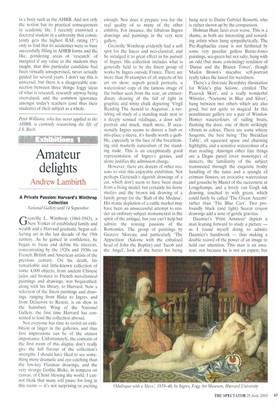Amateur delights
Andrew Lambirth
A Private Passion: Harvard's Winthrop Collection
National Gallery until 14 September
Grenville L. Winthrop (1864-1943), a New Yorker of established family and wealth and a Harvard graduate, began collecting art in the last decade of the 19th century. As he gained in confidence, he began to focus and define his interests, concentrating by the 1920s and 1930s on French, British and American artists of the previous century. On his death, his remarkable and little-known collection of some 4,000 objects, from ancient Chinese jades and bronzes to French neo-classical paintings and drawings, was bequeathed, along with his library, to Harvard. Now a selection of the finest paintings and drawings, ranging from Blake to Ingres, and from Delacroix to Renoir, is on show in the Sainsbury Wing of the National Gallery, the first time Harvard has consented to lend the collection abroad.
Not everyone has time to revisit an exhibition or linger in the galleries, and thus first impressions can be of the utmost importance. Unfortunately, the contents of the first room of this display don't really give the full flavour of the collection's strengths. I should have liked to see something more dramatic and eye-catching than the low-key Flaxman drawings, and the very strange Gothic Blake, in tempera on canvas, of Christ blessing the world. I cannot think that many will pause for long in this room — it's not surprising or exciting enough. Nor does it prepare you for the real quality of so many of the other exhibits. For instance, the fabulous Ingres drawings and paintings in the very next gallery.
Grenville Winthrop evidently had a soft spot for the linear and neo-classical, and he indulged it to great effect in his pursuit of Ingres. His collection includes what is generally held to be the finest group of works by Ingres outside France. There are more than 30 examples of all aspects of his art on show: superb pencil portraits, a watercolour copy of the famous image of the bather seen from the rear, an extraordinary drawing of the fall of light in graphite and white chalk depicting `Virgil Reading The Aeneid to Augustus', a ravishing oil study of a standing nude next to a deeply sensual odalisque, a dour selfportrait and much, much more. If occasionally Ingres seems to distort a limb or mis-place a sleeve, it's hardly worth a quibble, especially in the face of the breathtaking and masterly naturalism of the standing nude. This is an exceptionally good representation of Ingres's genius, and alone justifies the admission charge.
However, there are dozens of other reasons to visit this enjoyable exhibition. Not perhaps Gericault's tigerish drawings of a cat, which don't seem to have been made from a living model, but certainly his horse studies and the brown ink drawing of a family group for the `Raft of the Medusa'. His manic depiction of a cattle market may have been an unsuccessful attempt to render an ordinary subject monumental in the spirit of the antique, but you can't help but admire the rousing passions of the Romantics. The group of paintings by Gustave Moreau, and particularly `The Apparition' (Salome with the enhaloed head of John the Baptist) and `Jacob and the Anger, look all the better for being hung next to Dante Gabriel Rossetti, who is rather shown up by the comparison.
Holman Hunt fares even worse. This is a shame, as both are interesting and rewarding artists when hung sympathetically. The Pre-Raphaelite cause is not furthered by some very peculiar gutless Burne-Jones paintings, sea-green but not salty, hung with an odd (but more convincing) rendition of `Danae and the Brazen Tower', though Madox Brown's macabre self-portrait really takes the laurel for weirdness.
There's a first-rate Beardsley illustration for Wilde's play Salome, entitled 'The Peacock Skirt', and a really wonderful Whistler, 'Nocturne in Blue and Silver', hung between two others which are also good, but not quite so magical. In this penultimate gallery are a pair of Winslow Homer watercolours of sailing boats, flanking the door, one of them strikingly vibrant in colour. There are some whizzy Sargents, the best being `The Breakfast Table', all squeezed space and churning highlights, and a sensitive watercolour of a man reading. Amongst other fine things are a Degas pastel (over monotype) of dancers, the familiarity of the subject transmuted through the exquisite frothy handling of the tutus and a spangle of crimson flowers, an evocative watercolour and gouache by Manet of the racecourse at Longchamps, and a lovely van Gogh ink drawing, touched in with green, which could fairly be called 'The Green Accents' rather than 'The Blue Cart'. Two profoundly black (and light) Seurat crayon drawings add a note of gentle gravitas, Daumier's `Print Amateur' depicts a man leaning forward to study a picture — as I found myself doing to admire Daumier's handiwork — thus making a double record of the power of an image to hold our attention, This man is an amateur, not because he is not an expert, but because he loves prints. (There seems to be one rolled under his arm, no doubt a recent purchase.) This is just the kind of exhibition which encourages us to be amateurs — in the very best sense.



































































 Previous page
Previous page